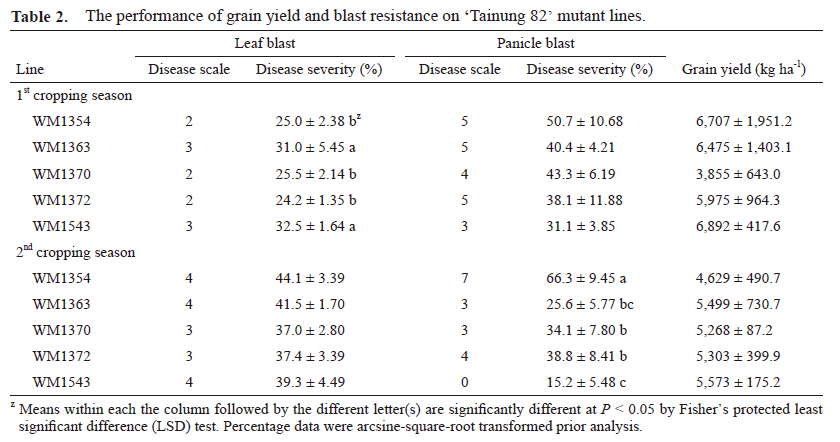All issues
Author:Dah-Jing Liao and Yong-Pei Wu*
Abstract:
The materials used for this study were rice variety ‘Tainung 82’ and its mutantlines. All the lines were cultivated in 5 different ratios of mixed combinations, 1 : 0, 3 : 1, 1 : 1, 1 : 3 and 0 : 1 in the first cropping season of 2016. The goal of this study was to investigate blast resistance, grain yield and predictability under mixed-line cultivation models. The results revealed that when the ratio of mixed-line cultivation increased, as compared to the individual cultivation of ‘Tainung 82’, the disease scale of leaf blast decreased from level 8 to 3, disease severity decreased from 88.7% to 28.7%, and the highest efficiency of improvement had reached 67.6%. The disease scale of panicle blast decreased from level 6 to 3, disease severity decreased from 65.6% to 40.0%, and the highest efficiency of improvement had reached 39.0%. The grain yield increased from 2,379 kg ha-1 to 4,986 kg ha-1, and the efficiency of improvement was 109.6%. However, the disease scale and severity of both leaf and panicle blast in the second cropping season decreased about 50.0% when compared to those of the first cropping season. As a result, there was no significant difference on the control effect between the mixed-line cultivation models and the control group, which could be due to typhoon during the experimental period. From September to October of 2016, there were several typhoons attacking Chiayi area, and strong wind and heavy rain decreased the spreading of the pathogen. As for the analysis and predictability for the disease scale of blast and grain yield under mixed-line cultivation models, the ratio of mixed line cultivation increased 1 unit (25.0%), the odds of resistance in the disease scale of leaf blast increased by 3,766-fold, the disease scale of leaf blast increased 7 times, the disease severity of leaf and panicle blast decreased by 14.5% and 5.1%, respectively, and grain yield increased by 18.7%. The accuracy, specificity and sensitivity of predictability for the disease scale of leaf blast under mixed-line cultivation models were greater than 80.0%, the disease scale of panicle blast ranged from 73.0 to 80.0%. The predictability for the disease severity of leaf and panicle blast would be explained by 91.1% and 41.6% of variance, respectively, and the grain yield would be explained by 57.5% of variance. Overall, the mixed-line cultivation models exhibited a great impact on the inhibition of blast and the control of rice blast and stability of grain yield. As for the predictability of mixedline cultivation models, the predictability of leaf blast was superior, but not in the panicle blast and grain yield, indicating that factors that affect panicle blast and grain yield are more complicated than those of leaf blast.
Key words:Rice, Blast, Mixed-line cultivation, Mutant lines, Logistic regression
Download:![]() PDF Links
PDF Links
- 1. Development of Tractor-Mounted Seedling Transplanter for Sweet Potato
- 2. Synergistic Effect of Additional Gas on the Toxicity of Phosphine to Sitophilus oryzae and Sitophilus zeamais (Coleoptera: Dryophthoridae)
- 3. Effects of Temperature and Solar Radiation on Growth Traits and Plant Elements in Purple Leafy Sweet Potato

 Submit your manuscript
Submit your manuscript
 Guide for authors
Guide for authors